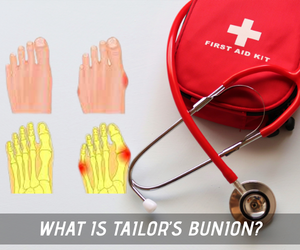
Bunions refer to the abnormal growth of bones around the area where your big and small toes meet your foot. A regular bunion is found on the big toe, and a tailor’s bunion on the small one.
A tailor’s bunions are similar to regular bunions but grow in different places. The typical bunions are found below the big toe on the inside of the feet. The outside of the foot, at the base of the little toe, is where Tailors Bunion occurs.
Contents
Savings For After Tailor’s Bunion Shoes [DEALs]
This article will tell you everything you need to know about Tailor’s Bunion. We also share the best treatment you can give for Tailor’s Bunion to speed up your recovery.
What’s Tailor’s Bunion?
A bunionette, also known as Tailor’s bunion, is a prominence of the fifth metatarsal bone at the base of the little toe. The five long, stubby bones that make up the foot are called the metatarsals.
A tailor’s bunion is distinguished by its prominent treatment options at the metatarsal heads, located at the bone’s end near the toe. Although they are less common than bunions that occur on the inside, tailor’s bunions can be pretty similar in their symptoms and cause fitting shoes. You can get a bunion split to treat this issue fast.
Tailor’s Bunion Symptoms
A tailor’s bunion refers to swelling outside your big toe. It might appear small at first, but it will grow over time. It may also become a reddish and painful foot and ankle. If the bunion rubs against your shoes, it can become the more painful and swollen edge of their feet. This type of bunion can be found on either one or both feet. One foot might have a worse bunion than the other. If the symptoms are minor, wear the best bunion socks to prevent the issue from worsening.
Redness, swelling, and pain around the enlargement area are all signs of the tailor’s bunion. This happens when shoes rub against the loose ligaments. It causes inflammation and irritation of the soft tissues beneath the skin.
On a side note, if you are suffering from arthritis knees, you can try the best shoes for arthritis knees to get rid of the pain.
Tailors Bunion Causes
A leading cause of tailor’s bunion is narrow shoes. High heels can cause your small toe to be pushed into your prominent toes symptoms of a tailor. A tailor’s bunny can also be caused by sitting cross-legged on one foot. In case of severe pain, you might need surgery. You can wear the best shoes after bunion surgery to alleviate the pain.
To relieve pressure from your toes caused by standing or sitting, you can try moving around often. The problem of tailor’s bunions usually develops in your youth and gets worse over time. The bunion can become painful by the time you are in your 40s.
Best Treatment for Tailor’s Bunion
These are various home remedies and medical treatment approaches that you can use to treat the Tailor’s Bunion.
Here are some treatment approaches that you can try yourself:
- To relieve your pain and stop the bunion from rubbing against the shoe, you can place a silicone bunion pad on top of the tailor’s bunion.
- The shoes with a large toe box and are flexible should be your preferred choice if you suffer from this issue. You need to avoid high heels and pointed shoes at all costs. You can choose the right running shoes if you are used to running daily.
- You can apply Ice to the foot for up to 5-10 minutes, maximum of 3 times daily. Also, to reduce swelling and pain, you can take nonsteroidal anti-inflammatory drugs (NSAIDs), such as ibuprofen.
- You can do calf stretches twice per day. With your toes pointed toward the wall, stand facing a wall. To stretch your tight calf muscles, move backward with the affected leg. You need to keep the same position for about 30-60 seconds.
- If home remedies don’t work, your doctor may recommend injections of corticosteroids to treat the bunion. Corticosteroids can reduce swelling. Your doctor may recommend a custom-made shoe insert to prevent or cushion the pain, tailors bunion growing, and relieve the bunions.
- Surgery may be an option if the swelling and pain persist or you cannot wear regular shoes due to the size of your tailor’s bunion. What is the best age to get bunion surgery? Since this is a relatively harmless procedure, there are no age limitations. Bunionette surgery can be done outpatient, so you can go home the same day as your procedure. You can try the best bunion correctors recommended by podiatrists to treat the issue.
Wrapping Up
Tailor’s Bunion is an unfortunate condition that can make walking quite difficult. If you are suffering from this issue, you must get treatment as soon as possible. You can try home remedies or get medical attention if your situation worsens. Also, you can read what bunion corrector works best to find a bunion corrector to ease the pain.
Feel free to contact us if you have any questions regarding the treatment for Tailor’s Bunion. Also, read this article to find the best wearing shoes after foot surgery.